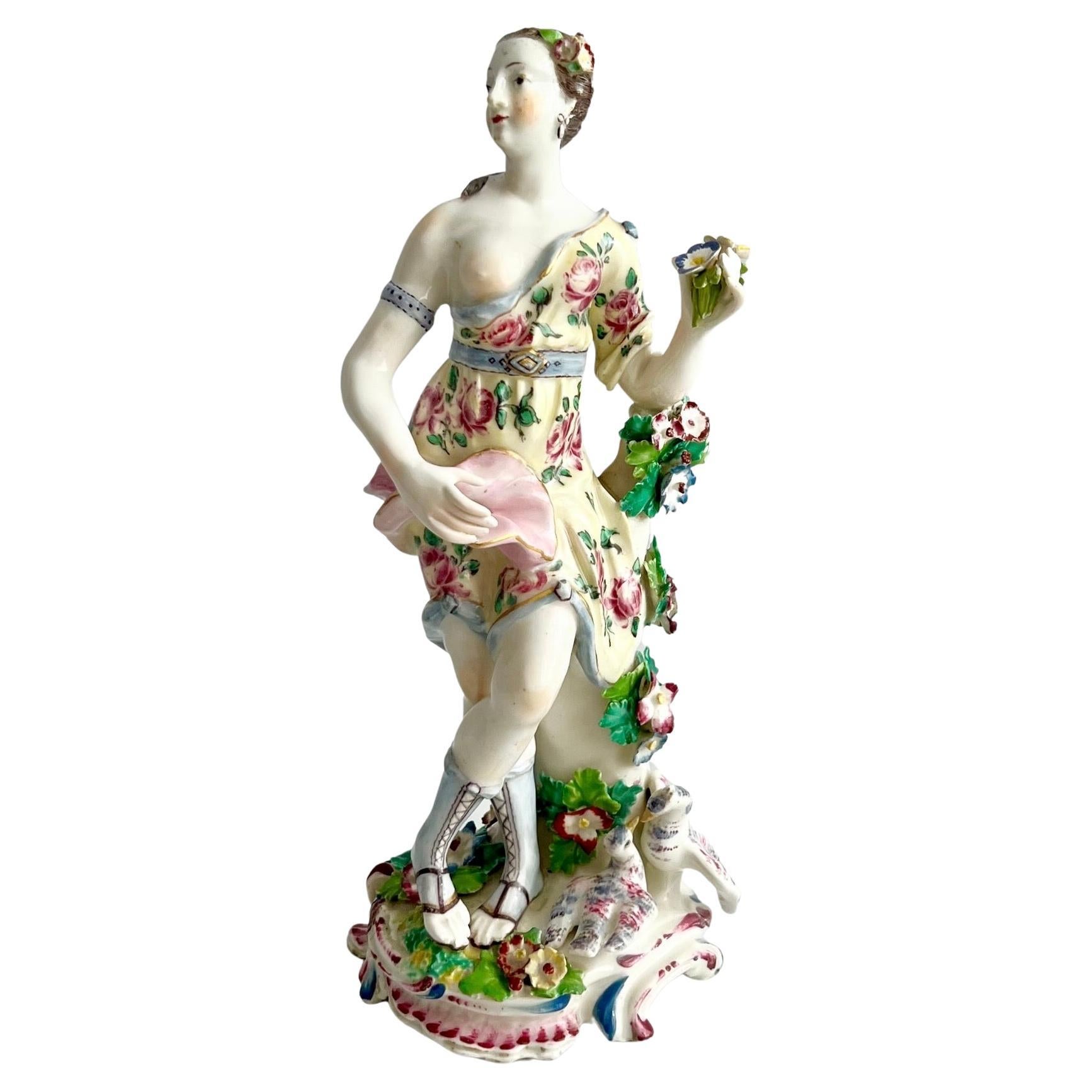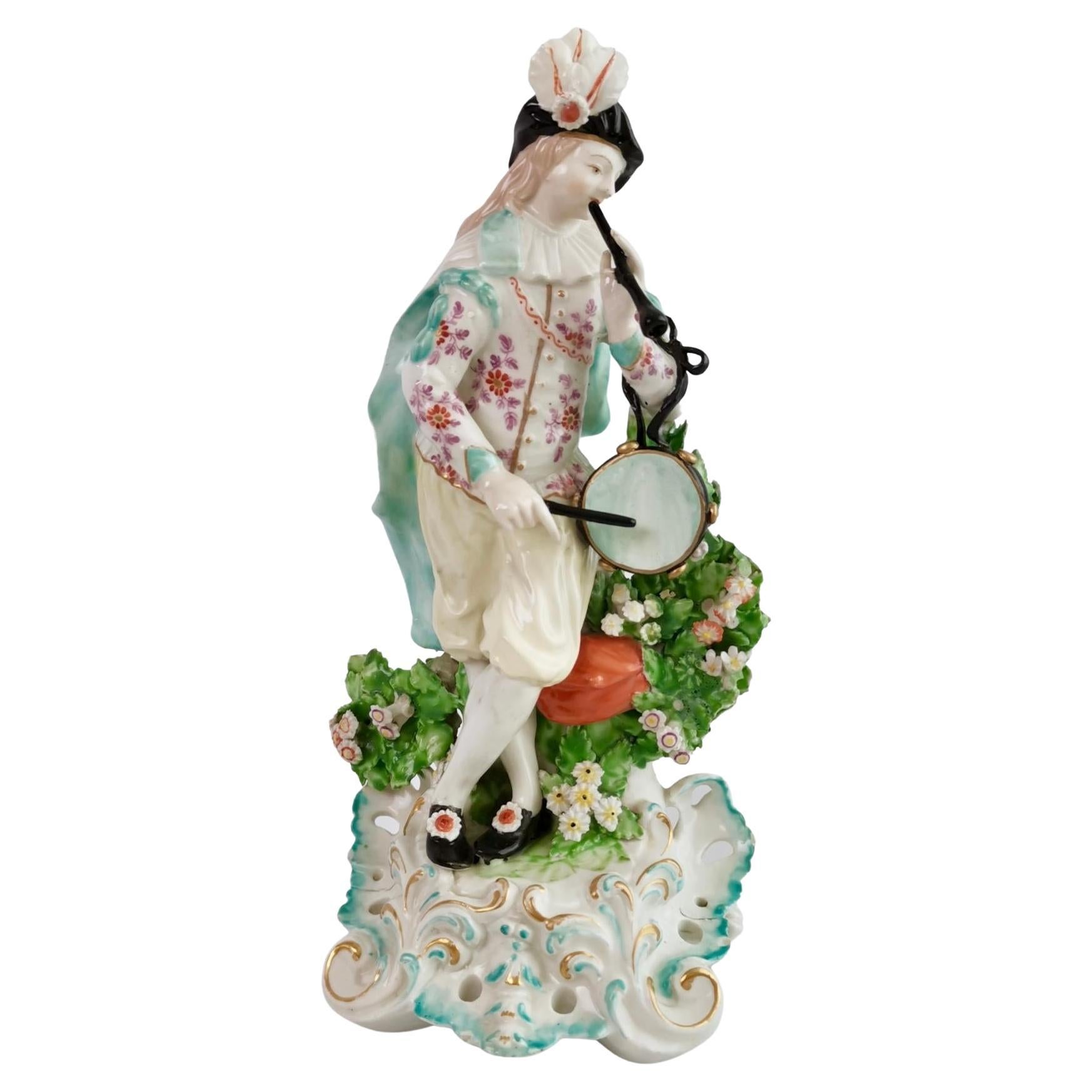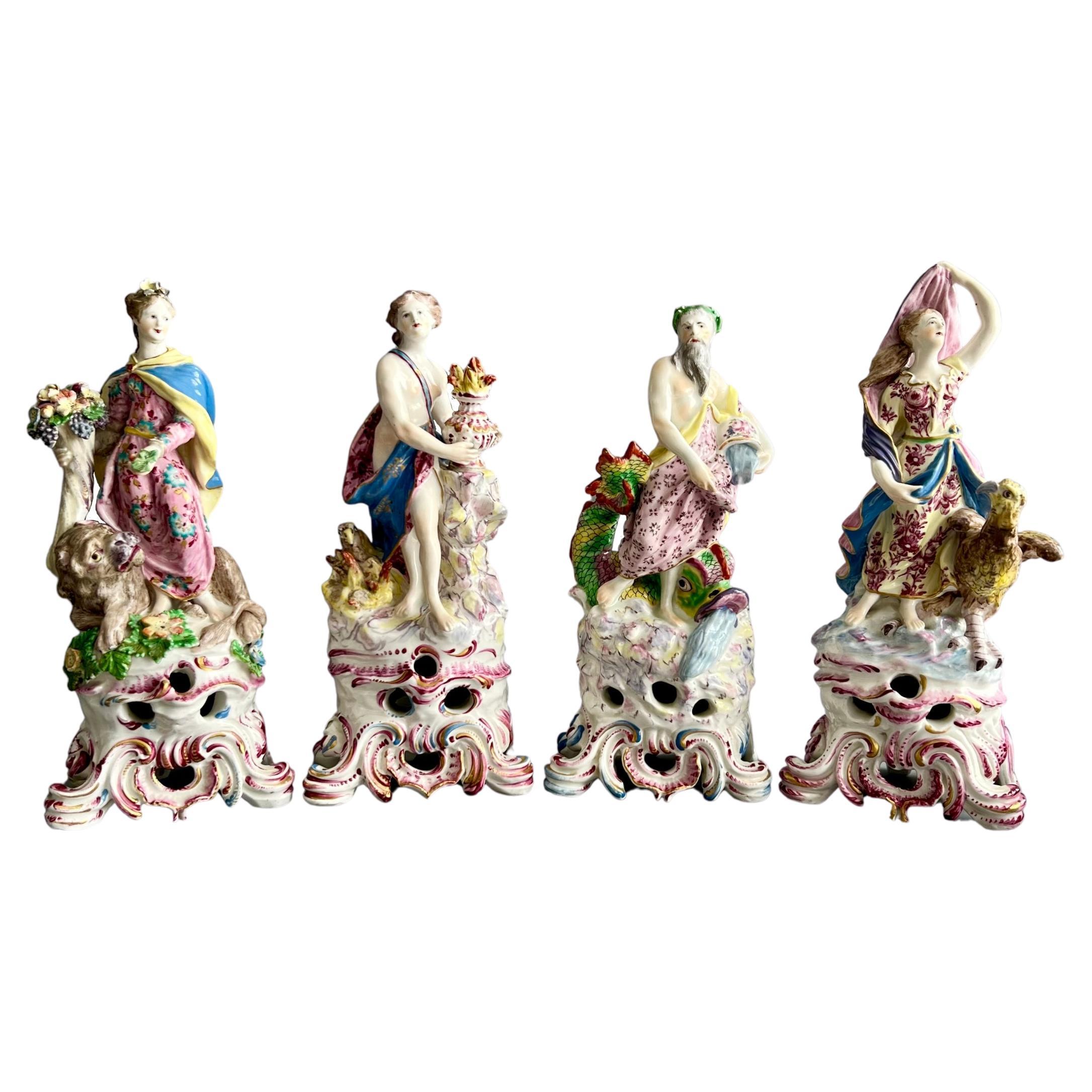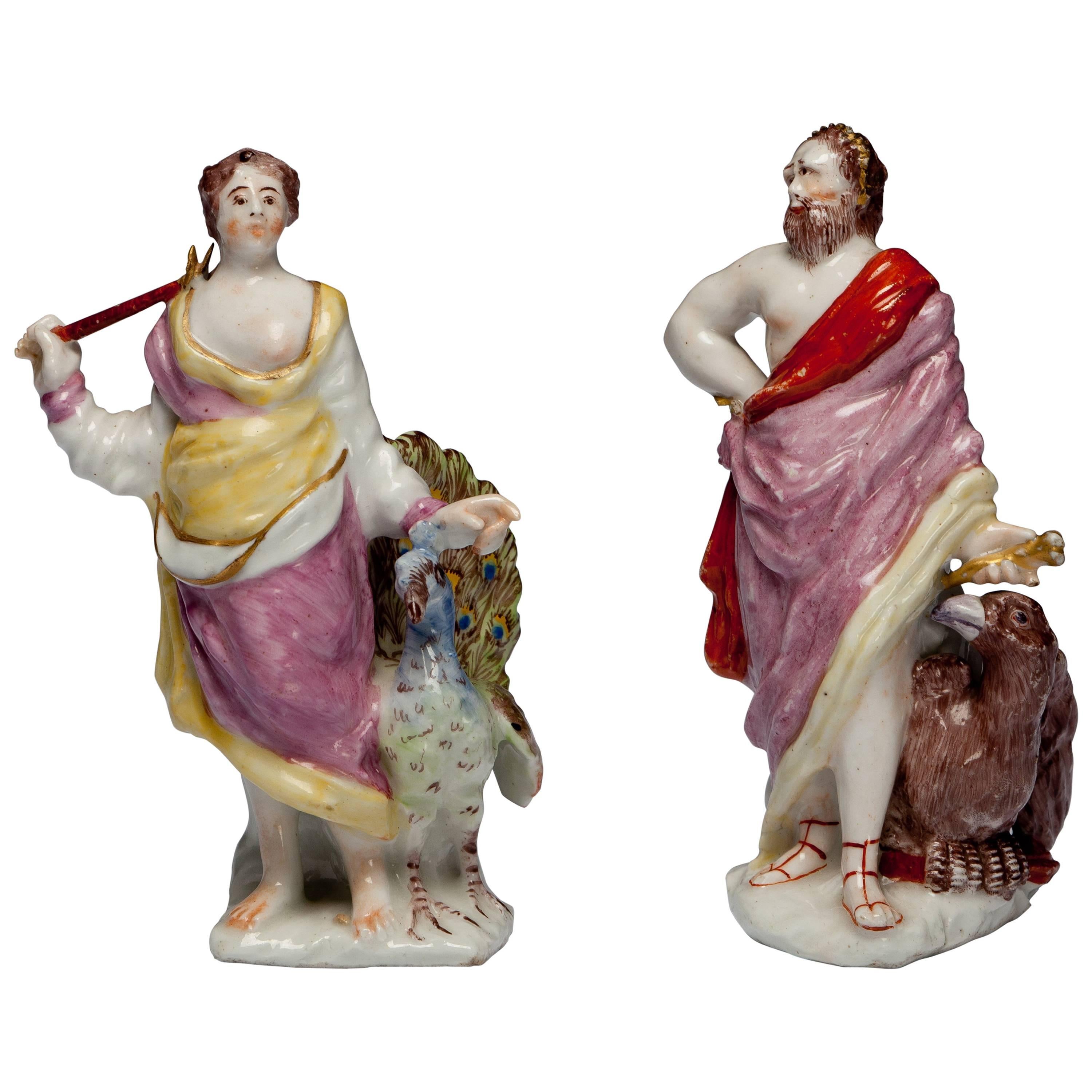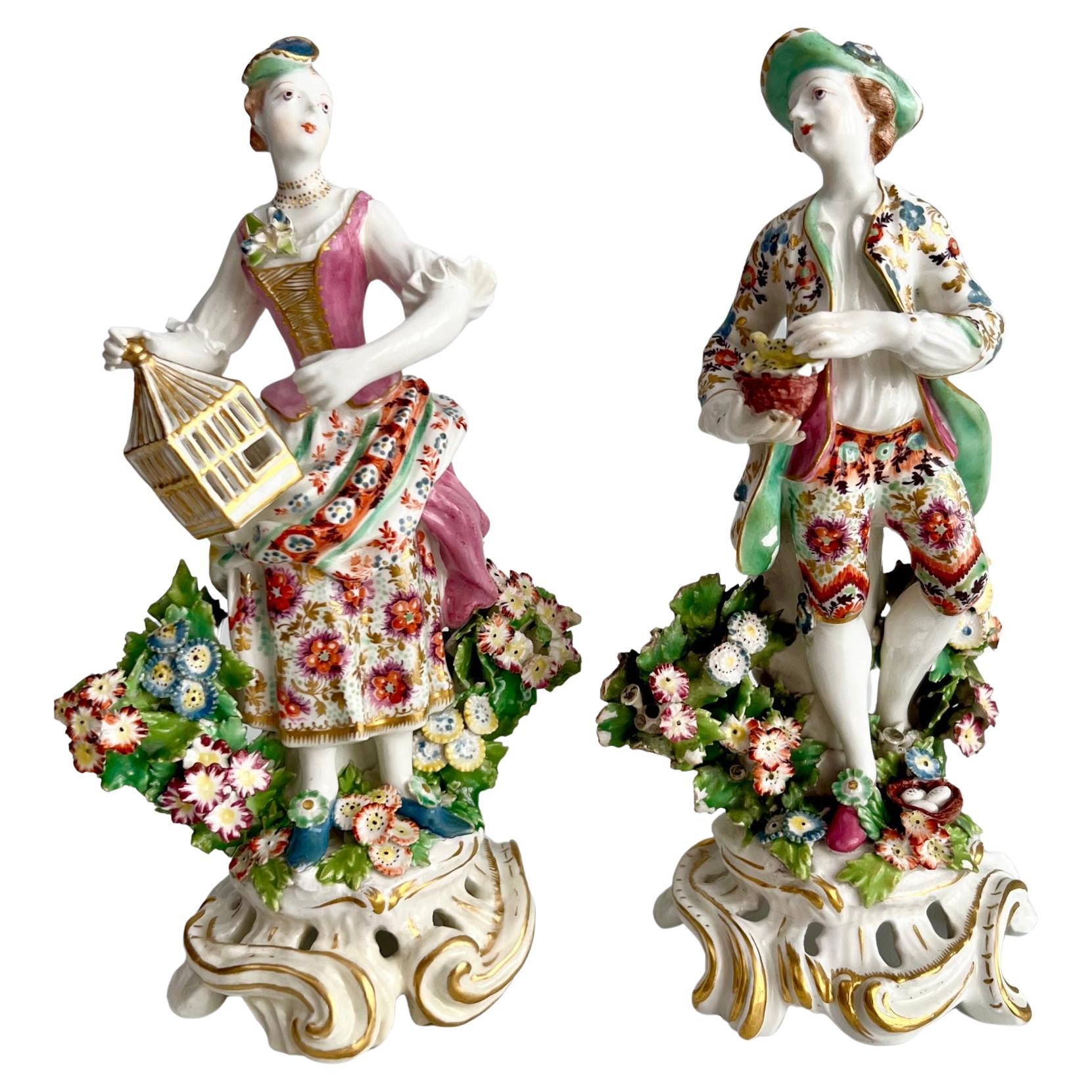Items Similar to Bow Porcelain Figure of Juno with Eagle 'Jupiter', Rococo Ca 1765
Want more images or videos?
Request additional images or videos from the seller
1 of 18
Bow Porcelain Figure of Juno with Eagle 'Jupiter', Rococo Ca 1765
About the Item
This is a very rare and impressive large figure of Juno with an eagle, made by the Bow Porcelain factory in about 1765. This figure formed part of a series of the Four Elements, with Juno representing air. The eagle at her feet represents Jupiter (or, in Greek mythology, Zeus). As with many Greek and Roman myths, Juno had quite a complicated relationship with Jupiter: he was both Juno's twin brother and her spouse. Here we see Jupiter in his transformed guise as an eagle, while Juno waves her garment in the wind signifying air.
The Bow Porcelain Factory was one of the first potteries in Britain to make soft paste porcelain, and most probably the very first to use bone ash, which later got perfected by Josiah Spode to what is now the universally used "bone china". Bow was the main competitor of the Chelsea Porcelain Factory, but where Chelsea made very fine slipcast porcelain, Bow made a different soft paste porcelain that tended to be softer and could be pressed into moulds. Bow served a larger public generally at lower prices. The factory was only in operation between 1743 and 1774, after which the tradition got incorporated into some of the later famous potteries such as Worcester and Derby.
These figures were used to adorn the dinner table when dessert was served; groups of figures served to express something about the host, the guests, or to direct the conversation. One popular series of figures was the Elements, consisting mostly of water, air, earth and fire. Bow copied many figures of the German Meissen series that were brought out in the decades before.
This figure dates from about 1765, which was at the height of Bow's ability to make beautiful figures often copied from Chelsea or Meissen. The porcelain is translucent with a beautiful milky glaze - Bow was probably the first factory using bone in its porcelain recipe. This particular copy of Juno is exceptionally colourful with a very refined face and the eagle seemingly in conversation with Juno, and it stands on a beautifully shaped base of Rococo scrolls.
The figure is marked with the red anchor and cross device. An image of this shape can be found in Peter Bradshaw's book on Bow Porcelain Figures, page 193, plate 203.
Provenance: the figure has a label of the shop of Arthur S. Vernay in New York City on the underside. Vernay was a well-known antiques dealer and explorer who ran a shop in New York between 1904 and 1943. It is interesting to think that this figure was made in East London more than 250 years ago, at some point ended up in New York, and then found its way back to East London again, only a stone's throw from the place where it was produced.
CONDITION REPORT The figure is in near-perfect condition, which is very rare to find. The only restoration to be found is the bunch of red flowers at Juno's feet - otherwise there is no damage, repairs, crazing or even any significant wear.
Antique British porcelain is never perfect. Kilns were fired on coal in the 1700s, and this meant that china from that period can have some firing specks from flying particles. British makers were also known for their experimentation, and sometimes this resulted in technically imperfect results. Due to the shrinkage in the kiln, items can have small firing lines or develop crazing over time, which should not be seen as damage but as an imperfection of the maker's recipes, probably unknown at the time of making. Items have often been used for many years and can have normal signs of wear, and gilt can have signs of slight disintegration even if never handled. I will reflect any damage, repairs, obvious stress marks, crazing or heavy wear in the item description but some minor scratches, nicks, stains and gilt disintegration can be normal for vintage items and need to be taken into account.
There is widespread confusion on the internet about the difference between chips and nicks, or hairlines and cracks. I will reflect any damage as truthfully as I can, i.e. a nick is a tiny bit of damage smaller than 1mm and a chip is something you can easily see with the eye; a glazing line is a break in the glazing only; hairline is extremely tight and/or superficial and not picked up by the finger; and a crack is obvious both to the eye and the finger. Etcetera - I try to be as accurate as I can and please feel free to ask questions or request more detailed pictures!
DIMENSIONS 29cm high (11.5").
- Creator:Bow Porcelain (Maker)
- Dimensions:Height: 11.5 in (29.21 cm)Width: 4.25 in (10.8 cm)Depth: 4.25 in (10.8 cm)
- Style:Rococo (Of the Period)
- Materials and Techniques:
- Place of Origin:
- Period:1760-1769
- Date of Manufacture:circa 1765
- Condition:Repaired: tiny flowers at Juno's feet are restored. Wear consistent with age and use. In near-perfect antique condition with one tiny professional repair.
- Seller Location:London, GB
- Reference Number:
About the Seller
5.0
Gold Seller
These expertly vetted sellers are highly rated and consistently exceed customer expectations.
Established in 2016
1stDibs seller since 2019
208 sales on 1stDibs
Typical response time: 1 hour
- ShippingRetrieving quote...Ships From: London, United Kingdom
- Return PolicyA return for this item may be initiated within 14 days of delivery.
More From This SellerView All
- Bow Porcelain Figure of Venus with Doves, Rococo, 1756-1764By Bow PorcelainLocated in London, GBThis is a rare and beautiful figure of Venus with two doves, made by the bow porcelain factory between 1756 and 1764. We see Venus standing holding her robe with one hand, a flower p...Category
Antique 1760s English Rococo Figurative Sculptures
MaterialsPorcelain
- Bow Complete Set of Porcelain Figures "The Four Elements", Rococo, circa 1765By Bow PorcelainLocated in London, GBThis is a very rare and impressive complete set of large figures called The Four Elements, made by the Bow Porcelain factory in about 1765. It consists of Ceres representing Earth, V...Category
Antique 1760s English Rococo Figurative Sculptures
MaterialsPorcelain
- Derby Porcelain Figure of Musician with Flageolet and Tabor, Rococo, Ca 1765By DerbyLocated in London, GBThis is a beautiful porcelain figure of a musician with a flageolet and tabor (fluit and drum), made by Derby around 1765, which was the Rococo era. The figure is one half of a pair ...Category
Antique 1760s English Rococo Figurative Sculptures
MaterialsPorcelain
- Bow Pair of Porcelain Figures, Arlecchino and Columbina, Rococo ca 1758By Bow PorcelainLocated in London, GBThis is a wonderful pair of figures of Arlecchino and Columbina, made by the Bow Porcelain factory in about 1758. These figures formed part of a series of the Commedia dell'Arte, a very popular series of theatrical figures that served as decoration at the dinner table in the 18th Century. The Bow Porcelain Factory was one of the first potteries in Britain to make soft paste porcelain, and most probably the very first to use bone ash, which later got perfected by Josiah Spode to what is now the universally used "bone china". Bow was the main competitor of the Chelsea Porcelain Factory, but where Chelsea made very fine slipcast porcelain, Bow made a different soft paste porcelain that tended to be softer and could be pressed into moulds. Bow served a larger public generally at lower prices. The factory was only in operation between 1743 and 1774, after which the tradition got incorporated into some of the later famous potteries such as Worcester and Derby. These figures were used to adorn the dinner table when dessert was served; groups of figures served to express something about the host, the guests, or to direct the conversation. The Italian Commedia Dell'Arte, a comical form of masked theatre, was very popular in those days and Bow copied many figures of the German Meissen series that were brought out in the decades before. This pair dates from about 1758, which was at the height of Bow's ability to make beautiful figurines often copied from Chelsea or Meissen. The pair is modelled after a Meissen pair by Kaendler. The porcelain is translucent with a beautiful milky glaze - Bow was probably the first pottery using bone in its porcelain recipe. Arlecchino (Harlequin) is playing the bagpipes, dressed in an odd costume of mismatched chintz and playing cards and wearing a funny black trumpet...Category
Antique 1750s English Rococo Figurative Sculptures
MaterialsPorcelain
- Bow Pair of Porcelain Figures of Liberty & Matrimony, Rococo 1760-1764By Bow PorcelainLocated in London, GBThis is a fabulous pair of figures of Liberty and Matrimony made by the Bow Porcelain factory between 1760 and 1764. These figures were a popular pair portraying marriage. The bow...Category
Antique 1760s English Rococo Figurative Sculptures
MaterialsPorcelain
- Bow Porcelain Figure of Boy or Putto on C-Scroll Base, Georgian circa 1760By Bow PorcelainLocated in London, GBThis is a wonderful little figure of a boy or putto made by the Bow Porcelain factory in about 1760. The Bow Porcelain Factory was one of the first potteries in Britain to make soft...Category
Antique 1760s English Rococo Figurative Sculptures
MaterialsPorcelain
You May Also Like
- Pair of figures: Jupiter and Juno, or Zeus and Hera. Bow Porcelain C1752By Bow PorcelainLocated in Melbourne, VictoriaShe stands barefoot, wearing a long-sleeved robe in white, deep pink and washed pale yellow and partly edged with gold; a red and gilt-topped sceptre in her right hand, an outsize pe...Category
Antique 1750s English Neoclassical Porcelain
MaterialsPorcelain
- Figure Columbine with her Hurdy Gurdy, Bow Porcelain Factory, circa 1756By Bow PorcelainLocated in Melbourne, VictoriaFrom the Commedia dell’arte, shown seated on a tree stump and playing her favourite instrument. Probably after Kandler, who described the model as a Tyrolean maiden playing a lyre. ...Category
Antique Mid-18th Century English Rococo Porcelain
MaterialsPorcelain
- Figure: Running Girl, Bow Porcelain Factory, circa 1756By Bow PorcelainLocated in Melbourne, VictoriaSmall figure of a young woman wearing a puce-sprigged white skirt, lifted slightly with her left hand, pale pink jacket with typical Bow opaque blue collar and cuffs. We've called...Category
Antique Mid-18th Century English Rococo Porcelain
MaterialsPorcelain
- Figure, Mercury, Bow Porcelain, circa 1748By Bow PorcelainLocated in Melbourne, VictoriaHe wears a winged helmet and sandals, a loosely draped pink, white, and yellow washed cloak over a short tunic, and leans arrogantly against bales, his message sack over his left sho...Category
Antique Mid-18th Century English Neoclassical Figurative Sculptures
MaterialsPorcelain
- A Bow Porcelain Figure of Winter, c1765By Bow PorcelainLocated in Tunbridge Wells, GBA Bow Porcelain Figure of Winter, c1765 Have named this version of winter "Dave" in tribute to the great and sorely missed observational Irish comedian Dave Allen. Additional information: Date : c1765 Period : George III Marks : None Origin : New Canton factory...Category
Antique 18th Century English George III Figurative Sculptures
MaterialsPorcelain
- Fortune Teller Figure. Bow Porcelain C1750By Bow PorcelainLocated in Melbourne, VictoriaA young woman standing with the remains of a staff in her left hand, and in apparent apprehension as her future and fortune is being read by an exotic, enigmatic, bearded figure, app...Category
Antique Mid-18th Century English Neoclassical Porcelain
MaterialsPorcelain
